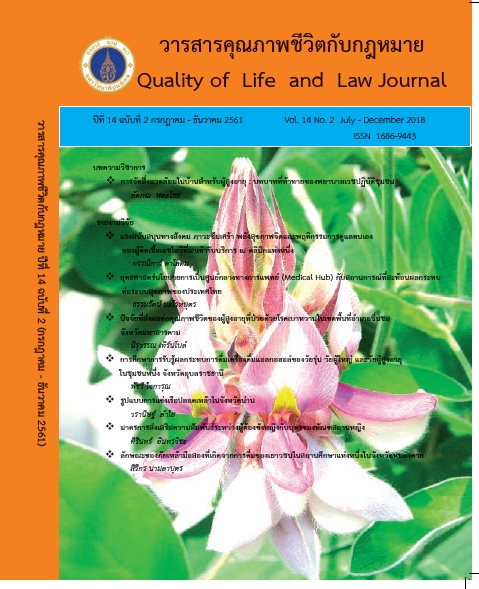Medical Hub Policy Strategy and Situations Reflecting Impact on the Health System of Thailand
Main Article Content
Abstract
The objective of the research titled “Medical Hub Policy Strategy and Situations Reflecting Impact on the Health System of Thailand” is to study and review situations amid the Medical Hub policy and its impacts on the health system of Thailand. The scope of study covers the “Center of Excellent Health Care of Asia” strategic plan (2004-2008) until the “Thailand as World Class Health Care Provider” strategic plan (2010-2014). The methodology is based on qualitative approach using documentary research from secondary and tertiary data in relation to the Medical Hub policy strategy, including the impacts on Thailand’s health system.
The findings revealed that the Medical Hub policy had its origin in the increasing number of foreigners traveling to Thailand for medical purposes, especially in the private sector. After the 1997 economic crisis in Thailand, private hospitals had to adapt themselves to revenue decreases by rendering more healthcare services to foreigners. In the meantime, the government used this opportunity to solve the economic problems seeking earnings for the country by means of providing healthcare to foreigners. The two strategies were therefore instigated through the actions of related public agencies. Throughout the implementation of the strategic plans, there had been an increase in the number of foreign healthcare receivers reflecting a success of the policy. However, there had also been a certain number of doctors and nurse practitioners resigning from the public sector during this period reflecting a brain drain to the private sector as the main service provider to the foreigners. This situation implied an impact on the health system of Thailand.
The research recommended that the participation in making and implementation of the Medical Hub policy should include all sectors namely the public, private and societal sectors in order to get comprehensive perspectives to solve problems and mitigate impacts incurred in the mainstream health system of the country. Moreover, the public and private sectors should establish mechanism and guidelines to share the use of medical resources, especially the human resources, in order to manage balance between the services provided by the private and public sectors as the public sector is the main provider in the national health system.
Article Details
- บทความหรือข้อคิดเห็นใดๆ ในวารสารคุณภาพชีวิตกับกฎหมายเป็
- กองบรรณาธิการไม่สงวนสิทธิ์
References
กรมสนับสนุนบริการสุขภาพ. (2560). ยุทธศาสตร์การพัฒนาประเทศไทยให้เป็นศูนย์กลางสุขภาพนานาชาติ (Medical Hub) (พ.ศ. 2560-2569). นนทบุรี: ผู้แต่ง.
ครรชิต พุทธโกษา. (2554). กรอบประเด็นการวิจัยของประเทศไทยให้พร้อมรับสถานการณ์การรวมกลุ่มประชาคมเศรษฐกิจอาเซียน. กรุงเทพฯ: สำนักงานคณะ
กรรมการวิจัยแห่งชาติ.
เดินหน้า "เมดิคัล ฮับ" เฟส 2. (2553, 24 พฤศจิกายน). โพสต์ทูเดย์, สืบค้นเมื่อ 25 สิงหาคม 2560, จาก https://www.posttoday.com/politic/report/61778
เพ็ญพิสุทธิ์ ศรีกาญจน์. (2557). บริการสุขภาพและบริการสังคม (Health and Social Services). กรุงเทพฯ: ผู้แต่ง.
ราชภัฏชัยภูมิ, มหาวิทยาลัย. (ม.ป.ป.). รายชื่อคณะพยาบาลศาสตร์ในประเทศไทย. สืบค้นเมื่อ 4 กุมภาพันธ์, 2560, จาก http://nu.cpru.ac.th/thai/?page_id=573
วรรณวิภา ปสันธนาธร, เสาวคนธ์ พีระพันธุ์, กวีพงษ์ เลิศวัชรา, และธวัชชัย บุญโชติ. (2552). รายงานการวิจัย ผลกระทบและการประมวลผลประโยชน์ที่ไทยได้รับจาก
การเปิดเสรีทางการค้า (FTA) ในภาคธุรกิจบริการสุขภาพ. กรุงเทพฯ: เจริญดีมั่นคงการพิมพ์.
สภาพัฒนาเศรษฐกิจและสังคมแห่งชาติ. (2548). ธุรกิจสุขภาพใน profile ภาคบริการ. กรุงเทพฯ: ผู้แต่ง.
สมานฉันท์ พุทธจักร. (2560, 29 มกราคม). ตรวจสอบ 10 เหตุผล ‘แพทย์ไหลออกจาก รพ.รัฐ’. ศูนย์ข้อมูล & ข่าวสืบสวนเพื่อสิทธิพลเมือง. สืบค้นเมื่อ 9 กันยายน
2560, จาก http://www.tcijthai.com/news /2017/29/scoop/6707
สํานักการค้าบริการและการลงทุน. (2554). สถานะความพร้อมธุรกิจบริการสาขาสุขภาพและวิชาชีพที่เกี่ยวเนื่อง. นนทบุรี: ผู้แต่ง.
สำนักข่าว Hfocus เจาะลึกระบบสุขภาพ. (2559). ปัญหาพยาบาลไทย ‘ขาดแคลน-กลไกรัฐไม่เอื้อดึงพยาบาลอยู่ในระบบ. สืบค้นเมื่อ 5 กุมภาพันธ์, 2561, จาก
https://www.hfocus.org/content/2016/04/ 11- 994
สำนักงานสถิติแห่งชาติ. (2556). การสำรวจโรงพยาบาลและสถานพยาบาลเอกชน พ.ศ. 2555. นนทบุรี: ผู้แต่ง.
สำนักงานส่งเสริมวิสาหกิจขนาดกลางและขนาดย่อม. (2553). คู่มือเพื่อการบริการท่องเที่ยวเชิงการแพทย์สําหรับผู้ประกอบการตัวแทนท่องเที่ยว. กรุงเทพฯ: ผู้แต่ง.
สำนักส่งเสริมธุรกิจบริการ. (2555). ธุรกิจบริการรักษาพยาบาล. นนทบุรี: ผู้แต่ง.
อดิศร ภัทราดูลย์. (ม.ป.ป.). แนวคิด ความสัมฤทธิผล และผลกระทบนโยบายประเทศไทยเป็นศูนย์กลางทางการแพทย์ของภูมิภาค (Medical Hub of Asia).
กรุงเทพฯ: คณะแพทยศาสตร์ จุฬาลงกรณ์มหาวิทยาลัย.
อรุณรัตน์ คันธา. (2557). ผลกระทบและทางออกของการขาดแคลนกำลังคนทางการพยาบาลในประเทศไทย. วารสารพยาบาลศาสตร์, 32 (1), 81-90.
อัญชนา ณ ระนอง. (2554). ภาวะวิกฤติเศรษฐกิจกับการเป็นศูนย์กลางบริการด้านสุขภาพของประเทศ ไทย. วารสารพัฒนบริหารศาสตร์, 51 (1), 47-81.
Cohen, E. (2008). Medical tourism in Thailand. AU-GSB e-Journal [online], 1, 1. Available: http://www.assumptionjournal.au.edu/index.php/AU-
GSB/article/view/381 [2018, March 21].
Institute for Population and Social Research. (2012). Thai Health 2012: Food Security - The illusion of money vs the reality of food. Nakhon
Pathom: Author.
Joint Commission International. (2018). Archive accreditation. Available: http://www. jointcommissioninternational.org [2018, April 25].
NaRanong, A., & NaRanong, V. (2011). The effects of medical tourism: Thailand’s experience. Bulletin of World Health Organization, 89, 336–344.
Pachanee, C. (2009). Implications on public health from Mode 2 Trade in Health Services: Empirical evidence (a case of Thailand). Paper
presented at the Workshop on the Movement of Patients across International Borders - Emerging Challenges and Opportunities for Health
Care Systems, 24-25 February 2009, Kobe, Japan.
Ricafort, K.M.F. (2011). A study of influencing factors that lead medical tourists to choose Thailand hospitals as medical tourism destination.
Research paper, School of Business and Technology, Webster University.


